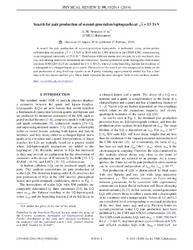Search for pair production of second-generation leptoquarks at √s = 13 TeV
| dc.contributor.author | Sirunyan, A. M. | |
| dc.contributor.author | Işıldak, Bora | |
| dc.date.accessioned | 2020-09-07T12:13:39Z | |
| dc.date.available | 2020-09-07T12:13:39Z | |
| dc.date.issued | 2019-02-27 | |
| dc.identifier.issn | 1550-7998 | en_US |
| dc.identifier.uri | http://hdl.handle.net/10679/6912 | |
| dc.identifier.uri | https://journals.aps.org/prd/abstract/10.1103/PhysRevD.99.032014 | |
| dc.description.abstract | A search for pair production of second-generation leptoquarks is performed using proton-proton collision data collected at root s = 13 TeV in 2016 with the CMS detector at the CERN LHC, corresponding to an integrated luminosity of 35.9 fb(-1). Final states with two muons and two jets, or with one muon, two jets, and missing transverse momentum are considered. Second-generation scalar leptoquarks with masses less than 1530(1285) GeVare excluded for ss = 1.0(0.5), where ss is the branching fraction for the decay of a leptoquark to a charged lepton and a quark. The results of the search are also interpreted as limits on the pair production of long-lived top squarks in an R-parity violating supersymmetry model that has a final state with two muons and two jets. These limits represent the most stringent limits to date on these models. | en_US |
| dc.description.sponsorship | BMWFW and FWF (Austria); FNRS and FWO (Belgium); CNPq, CAPES, FAPERJ, and FAPESP (Brazil); MES (Bulgaria); CERN; CAS, MoST, and NSFC (China); COLCIENCIAS (Colombia); MSES and CSF (Croatia); RPF (Cyprus); SENESCYT (Ecuador); MoER, ERC IUT, and ERDF (Estonia); Academy of Finland, MEC, and HIP (Finland); CEA and CNRS/IN2P3 (France); BMBF, DFG, and HGF (Germany); GSRT (Greece); NKFIA (Hungary); DAE and DST (India); IPM (Iran); SFI (Ireland); INFN (Italy); MSIP and NRF (Republic of Korea); LAS (Lithuania); MOE and UM (Malaysia); BUAP, CINVESTAV, CONACYT, LNS, SEP, and UASLP-FAI (Mexico); MBIE (New Zealand); PAEC (Pakistan); MSHE and NSC (Poland); FCT (Portugal); JINR (Dubna); MON, RosAtom, RAS and RFBR (Russia); MESTD (Serbia); SEIDI, CPAN, PCTI and FEDER (Spain); Swiss Funding Agencies (Switzerland); MST (Taipei); ThEPCenter, IPST, STAR, and NSTDA (Thailand); TUBITAK and TAEK (Turkey); NASU and SFFR (Ukraine); STFC (United Kingdom); DOE and NSF (USA). Individuals have received support from the Marie-Curie program and the European Research Council and Horizon 2020 Grant, Contract No. 675440 (European Union); the Leventis Foundation; the A. P. Sloan Foundation; the Alexander von Humboldt Foundation; the Belgian Federal Science Policy Office; the Fonds pour la Formation 'a la Recherche dans l'Industrie et dans l'Agriculture (FRIA-Belgium); the Agentschap voor Innovatie door Wetenschap en Technologie (IWT-Belgium); the F.R.S.-FNRS and FWO (Belgium) under the "Excellence of Science-EOS"-be.h project no. 30820817; the Ministry of Education, Youth and Sports (MEYS) of the Czech Republic; the Lendulet ("Momentum") Programme and the Janos Bolyai Research Scholarship of the Hungarian Academy of Sciences, the New National Excellence Program UNKP, the NKFIA research Grants No. 123842, No. 123959, No. 124845, No. 124850 and No. 125105 (Hungary); the Council of Science and Industrial Research, India; the HOMING PLUS program of the Foundation for Polish Science, cofinanced from European Union, Regional Development Fund, the Mobility Plus program of the Ministry of Science and Higher Education, the National Science Center (Poland), contracts Harmonia 2014/14/M/ST2/00428, Opus 2014/13/B/ST2/02543, 2014/15/B/ST2/03998, and 2015/19/B/ST2/02861, Sonata-bis 2012/07/E/ST2/01406; the National Priorities Research Program by Qatar National Research Fund; the Programa Estatal de Fomento de la Investigacion Cientifica y Tecnica de Excelencia Maria de Maeztu, Grant No. MDM-2015-0509 and the Programa Severo Ochoa del Principado de Asturias; the Thalis and Aristeia programs cofinanced by EU-ESF and the Greek NSRF; the Rachadapisek Sompot Fund for Postdoctoral Fellowship, Chulalongkorn University and the Chulalongkorn Academic into Its 2nd Century Project Advancement Project (Thailand); the Welch Foundation, Contract No. C-1845; and the Weston Havens Foundation (USA). | |
| dc.language.iso | eng | en_US |
| dc.publisher | American Physical Society | en_US |
| dc.relation.ispartof | Physical Review D | |
| dc.rights | openAccess | |
| dc.title | Search for pair production of second-generation leptoquarks at √s = 13 TeV | en_US |
| dc.type | Article | en_US |
| dc.description.version | Publisher version | en_US |
| dc.peerreviewed | yes | en_US |
| dc.publicationstatus | Published | en_US |
| dc.contributor.department | Özyeğin University | |
| dc.contributor.authorID | (ORCID 0000-0002-0283-5234 & YÖK ID 124605) Işıldak, Bora | |
| dc.contributor.ozuauthor | Işıldak, Bora | |
| dc.creator | The CMS Collaboration | |
| dc.identifier.volume | 99 | en_US |
| dc.identifier.issue | 3 | en_US |
| dc.identifier.wos | WOS:000459908000001 | |
| dc.identifier.doi | 10.1103/PhysRevD.99.032014 | en_US |
| dc.identifier.scopus | SCOPUS:2-s2.0-85062629289 | |
| dc.contributor.authorMale | 1 | |
| dc.relation.publicationcategory | Article - International Refereed Journal - Institution Academic Staff |
Files in this item
This item appears in the following Collection(s)
Share this page



